7 Major Ports in Saudi Arabia
The Kingdom of Saudi Arabia is situated in Western Asia, covering the Arabian peninsula. Rated as the 19th largest economy in the world, it is the leading exporter of petroleum and oil.
It also possesses a significant proportion of natural gas reserves and mineral deposits. Saudi Arabia has trade relations with China, the US, Germany, Japan, India, Singapore, United Arab Emirates, and Britain.
It has a strong agricultural sector producing export quality dates, vegetables, packaged food, etc. A diverse industrial base resting on major industries like plastics, organic chemicals and petrochemicals drives national economic growth.
Sharing maritime borders with the Red Sea on its western side and the Persian Gulf to its east, Saudi Arabia has made heavy investments in developing its international port facilities. It has around 20 ports and terminals, the busiest being the Jeddah and the Dammam Ports.
Till 1976, the nation’s ports were managed by different agencies however an Independent Ports Authority was created in 1977 which privatised port operations while playing a supervisory role. In this article, let us explore the 7 major ports of Saudi Arabia.
1. Jeddah Islamic Port
Lying on Saudi Arabia’s Red Sea coast, Jeddah Port is the busiest in the country. It is also the primary port serving the Muslim holy cities of Mecca and Medina. The third-largest city in Saudi Arabia, Jeddah has a long history of trading, situated at the crossroads of key land and maritime trade routes. Today, it is home to numerous successful businesses and wealthy Arabian merchant families.
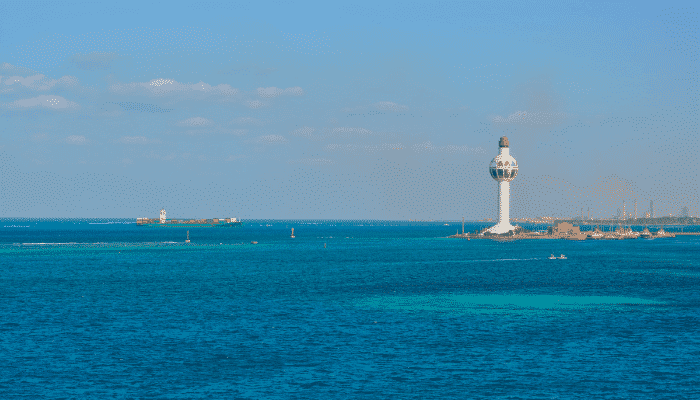
Jeddah port is also called the commercial capital of Saudi Arabia, strategically positioned amidst Africa and the Middle East, making it an important trade and financial hub of the subcontinent. It is the principal gateway for Saudi Arabia’s exports and imports, handling around 75 per cent of the nation’s global maritime trade. It is also a key transhipment centre of the Red sea, serving the landlocked nations of the region.
Its foundation was laid in 645 AD during the reign of Caliph Uthman Bin Affan but the construction of the modern port commenced only in 1976.
Port Specifications
The port covers 12.5 square kilometres and comprises 62 berths divided among 4 terminal facilities. Connecting three continents, the port has an annual handling capacity of 130 million tonnes and receives more than 5000 vessels every year. A multipurpose port, it deals with containerised goods, general cargo, livestock, bulk grains, automobiles, oil and petroleum.
It also contains a logistics park that comprises over 15 warehouses, 3 open storage yards, refuelling facilities and truck terminals.
Managed by the Port Authority of Jeddah, the subsidiary port of Shuaiba lies approximately 75 nautical miles from Jeddah port and comprises three jetties for accommodating oil tankers. It is jointly owned by private companies operating in the main port.
Container Terminals
The North Container Terminal spans 107 hectares and contains 7 berthing positions for accommodating the biggest container ships. It is equipped with reefer gantry platforms for efficient handling of reefer containers. The Southern Container Terminal covers 62 hectares and incorporates six wharves with an alongside depth of 16 m. The combined annual handling capacity of both facilities is 7.5 million TEUs.
Around 70,000 TEUs pass through the Red Sea Gateway Terminal, a fully automated state-of-the-art terminal, covering 50 hectares. Equipped with the latest port operating system, it consists of 4 docks, a feeder berth, 2 terminal buildings and a logistics depot. It has a 300 m wide deepwater channel that can accommodate next-generation cargo vessels. Jeddah port also has a livestock terminal dealing with 7 million heads annually.
2. King Abdul Aziz Port/ Dammam Port
Located in the city of Dammam, King Abdul Aziz Port is the biggest facility on the Persian Gulf and one of the busiest ports in the Middle Eastern and North African regions. It is the key maritime gateway and entry point for goods headed to Saudi Arabia’s central and eastern regions. Dammam port also serves the regional oil and natural gas industry and contributes to the development of the capital city, Riyadh. The second-largest commercial port in the country, it is linked to all major dry ports through railways.
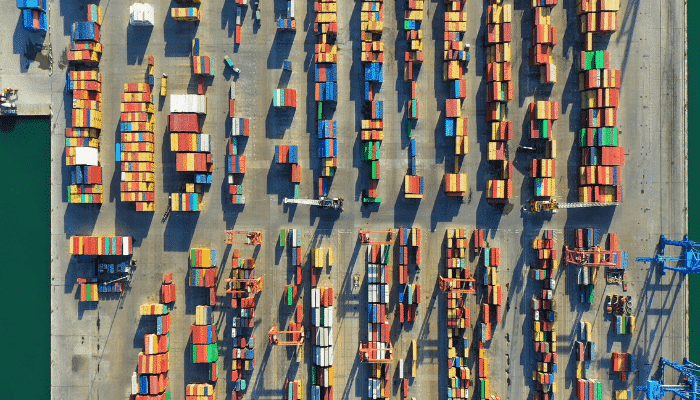
The Port was established under the orders of Saudi Arabia’s King Abdulaziz bin Abdulrahman Al Saud to meet the growing demands of the country’s oil industry. The development contract was given to Saudi Aramco, a prominent oil and natural gas company. Around 105 million tonnes of cargo is handled at the port every year.
Port Layout
King Abdul Aziz port contains a huge housing complex for its employees, a mosque, a hospital, a fire department and a supermarket. It has separate electrical and marine communication networks and desalination plants. Connected with the rest of Saudi Arabia via highways, it covers around 19,000 hectares of land area, including a 13.5-hectare ship repair complex, two maintenance docks and a training centre.
It also has a 310-foot tall port tower and special stations for packaged and frozen food, consumer goods and electrical appliances. It also handles all sorts of containerised cargo, automobiles, construction material and heavy machinery. It has 43 wharves and 3 multipurpose terminals for accommodating mega-ships.
The Container terminal is operated by International Port Services, a subsidiary of Hutchison Port Holdings. The IPS terminal covers 70 hectares and has 6 container wharves and 2 roro berths. It also has a temperature-controlled reefer facility with 1739 reefer connections.
The port has two cement terminals, one for black portland cement and clinker exports while the other is dedicated to white portland cement. It has an automated grain terminal with 10 silo tanks, an iron ore terminal and two oil and gas facilities for handling crude oil, LPG and LNG.
3. King Fahad Industrial Port in Yanbu
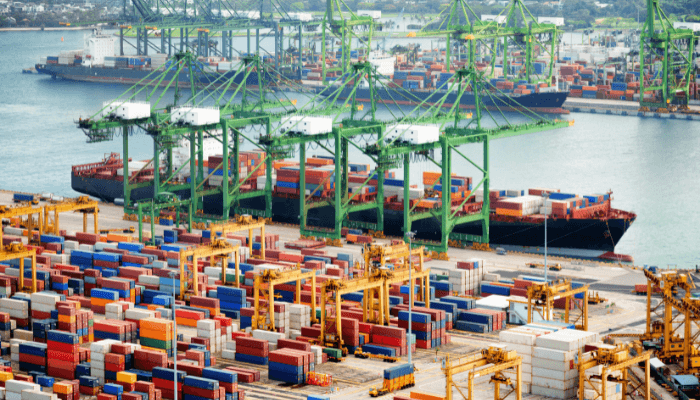
Lying on the western shores of the Red Sea, King Fahad Industrial Port in Yanbu is the Kingdom’s biggest outlet for crude and refined petroleum including petrochemicals. It is close to the Far East, Europe, North America and the shipping routes traversing the Suez Canal and Bab Al Mandab Strait. The port was constructed in 1980 and also serves the major industrial complexes by exporting their products and importing production equipment. It has a natural harbour that is protected by expansive coral reefs on both sides.
Yanbu port covers 6.8 square kilometres and consists of 34 berths divided among 10 modern terminals with an annual cargo throughput of around 210 million tonnes. It can accommodate ships weighing up to 500,000 tonnes.
Port Terminals
The bulk terminal incorporates two wharves covering 500 m for handling shipments of sulphur. With average water depths of 16 m, this facility can accommodate 60,000 DWT vessels. The Crude Oil Terminal has a trestle jetty with 5 loading berths that can accommodate vessels up to 500,000 DWT.
The Petroleum Derivatives Export Terminal handles benzene, diesel, oil etc on its 5 dedicated oil berths, capable of accommodating 150,000 DWT oil tankers. The Petrochemicals terminal has 7 wharves for mooring 40,000 DWT vessels. These wharves export liquid petrochemical products such as propylene and glycol.
The Natural Gas Terminal has three berths with alongside depths of 18.3 metres for handling propane, butane, and naphtha.
The King Fahad Industrial Port in Yanbu has ample storage facilities including 168,000 m2 for container storage. It also has a reefer container area with 40 power plugs for reefer containers. The general cargo terminal has 10,000 m2 of open storage area and 18,000 m2 of covered warehouse space.
4. Yanbu Commercial Port
Yanbu port was constructed near Saudi Arabia’s oldest port along the west coast. The modern facility became operational in 1965, during the reign of late King Faisal. Its geographical location enables it to serve the economies of the Medina and Qassim regions, two of the Kingdom’s most flourishing trade centres. It is a subsidiary port of the King Fahad Industrial Port in Yanbu and has 12 berths capable of handling around 15 million tonnes annually.
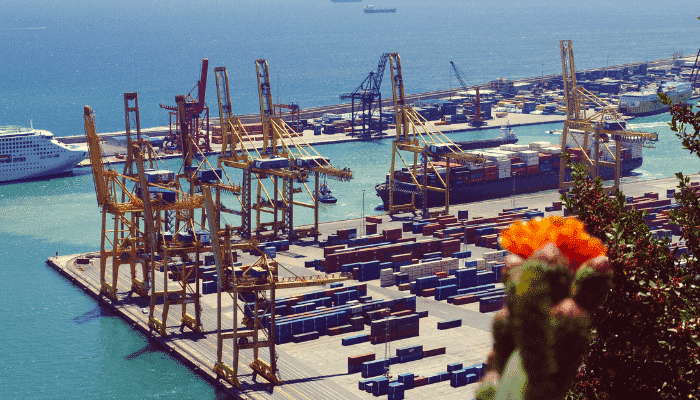
It has a modern passenger terminal for accommodating cruises, yachts and passenger vessels with more than 1500 people on board. It also consists of a general cargo terminal and a grain terminal with two bulk silos, capable of storing 40,000 tonnes. The port is connected to Makkah and Medina through a network of expressways.
5. Jubail Commercial port
Jubail port lies on the central coast of Saudi Arabia in the Arabian Gulf. It covers 44 square kilometres and is one of the largest artificial harbours in the world, made on reclaimed land. Its proximity to the Kingdom’s major industrial and petrochemical complex helps to decrease the freight costs and boosts the nation’s trade competitiveness.
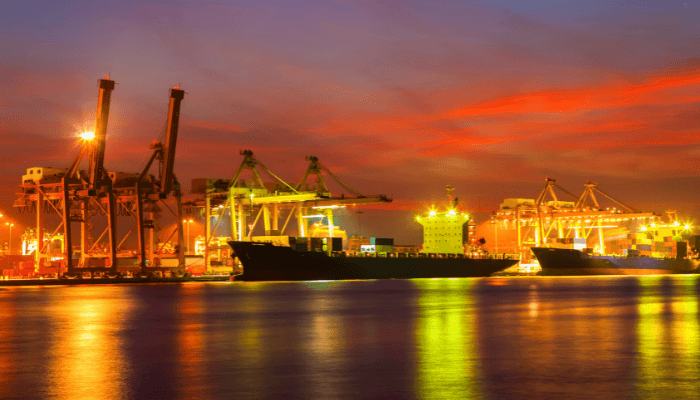
The Jubail commercial port was inaugurated in 1976 by King Khalid Ib Abdulaziz Al Saud and the construction was completed in 1979. It has 16 berths with an annual handling capacity of 36 million tonnes.
Jubail port mainly deals with general cargo, containers, petrochemicals, industrial goods, refined oil and frozen foodstuff. It was a famous fishing harbour in the 19th century and the modern port was created to support the industrial zones of Saudi Arabia’s eastern provinces.
Port Layout
The port has four terminal facilities. The container terminal covers 140,000 m2 and has 120 reefer connections and a 100,000 m2 container yard for accommodating 20,000 TEUs. The container freight station comprises four storage sheds with a total area of 18,000m2.
The port’s RORO terminal contains 5 wharves with stern ramps for accommodating pure car carriers. The general cargo terminal can handle around 20 million tonnes annually on its 8 dedicated berths. It also has a 900,000 m2 open storage area and 87,000 m2 of warehouse space.
6. King Fahad Industrial Port, Jubail
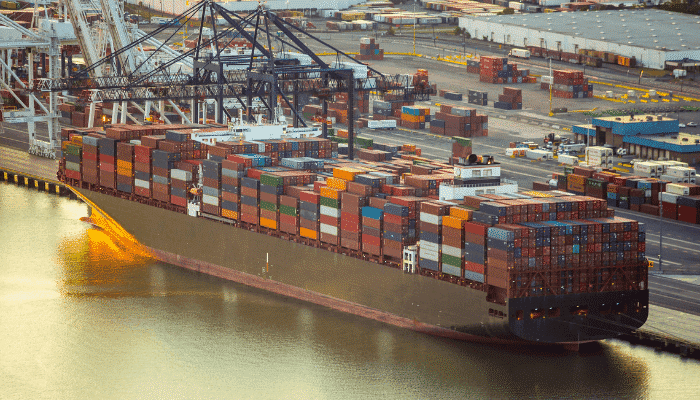
It is a part of the Jubail commercial port and is known as the biggest industrial port of the Middle East, inaugurated by the late King Fahad Bin Abdulaziz in 1982. It was specially designed to reduce congestion and traffic at the Jubail commercial port. It handles raw material imports required by the region’s local industries and ships petrochemical products, chemical fertilisers and sulphur worldwide.
Close to the Jubail industrial city, it covers around 7 km2 and consists of 34 specialised berths. The total annual cargo throughput of this port stands at 70 million tonnes.
7. Port of Jazan/Jizan
Jazan port is located on Saudi Arabia’s eastern coast facing the Red Sea near the border of Yemen. It serves the southern part of the Kingdom as the main gateway for livestock imports from Africa. Opened in 1976, it is also close to the Bab Al Mandab Strait and has trade links with Europe, the Far East, East Africa and the Middle East.
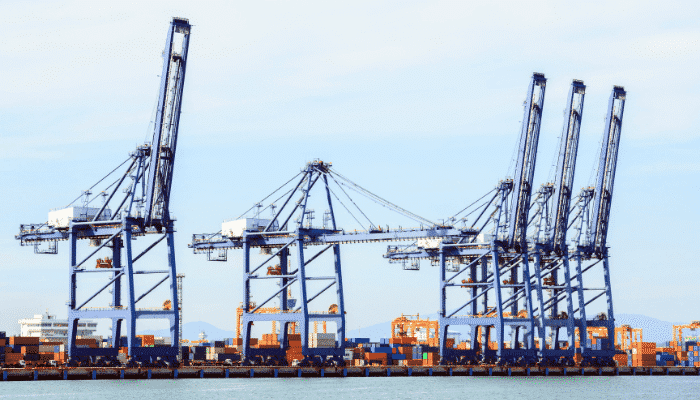
The port underwent three stages of expansion for building additional wharves, a control tower, 16 warehouses, a power station, fuelling stations, 2 desalination plants, offices and residential buildings.
It covers 5 km2 and contains 12 berths and 3 approach channels. It also has an oil terminal and SPM berths. Anchorage is possible to the west of the fish point. Apart from livestock, it also handles general cargo, barley, foodstuff and cement clinker. A passenger terminal is also located at the port and the Farasan island.
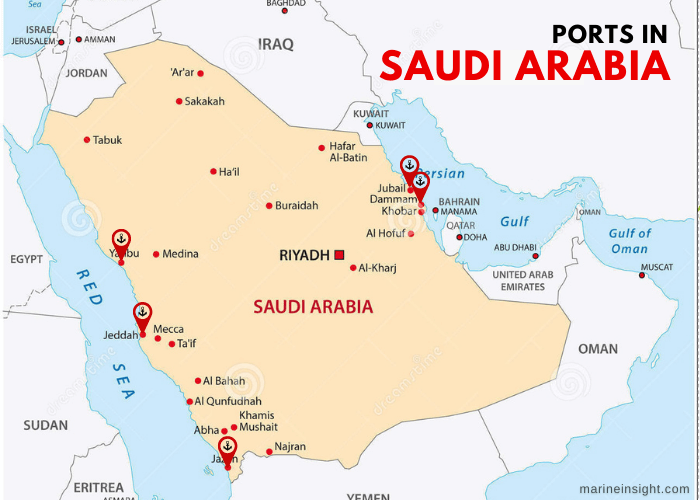
You might also like to read:
- 8 Major Ports of Taiwan
- 6 Major Ports of North Korea
- 5 Major Ports in Colombia
- 7 Major Ports in Sweden
- 6 Major Ports in Finland
Disclaimer :
The information contained in this website is for general information purposes only. While we endeavour to keep the information up to date and correct, we make no representations or warranties of any kind, express or implied, about the completeness, accuracy, reliability, suitability or availability with respect to the website or the information, products, services, or related graphics contained on the website for any purpose. Any reliance you place on such information is therefore strictly at your own risk.
In no event will we be liable for any loss or damage including without limitation, indirect or consequential loss or damage, or any loss or damage whatsoever arising from loss of data or profits arising out of, or in connection with, the use of this website.
Do you have info to share with us ? Suggest a correction
Disclaimer :
The information contained in this website is for general information purposes only. While we endeavour to keep the information up to date and correct, we make no representations or warranties of any kind, express or implied, about the completeness, accuracy, reliability, suitability or availability with respect to the website or the information, products, services, or related graphics contained on the website for any purpose. Any reliance you place on such information is therefore strictly at your own risk.
In no event will we be liable for any loss or damage including without limitation, indirect or consequential loss or damage, or any loss or damage whatsoever arising from loss of data or profits arising out of, or in connection with, the use of this website.

About Author
Shilavadra Bhattacharjee is a shipbroker with a background in commercial operations after having sailed onboard as a Third Officer. His interests primarily lie in the energy sector, books and travelling.
Latest Maritime Knowledge Articles You Would Like:
Subscribe To Our Newsletters
By subscribing, you agree to our Privacy Policy and may receive occasional deal communications; you can unsubscribe anytime.















